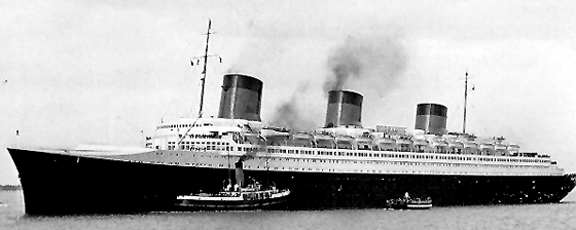| The Normandie The Grand French Lady |
| Owners: Compagnie Generale Transatlantique (the French Line) Builders: Penhoet Shipyards, Saint Nazaire, France Launched: October 29, 1932 Maiden Voyage: May 29, 1935 Length: 1029 feet Weight: 79,280 (83,423 after 1936) Top Speed: 32.2 knots Passenger Capacity: 2917 Demise: Burned and capsized on February 9, 1942 |
| The Normandie is considered by many people to be the most beautiful ocean liner ever built. Her graceful lines and powerful appearance struck awe into all who sailed upon her. Her designer, Vladamir Yourkevitch, had originally gone to Cunard Line to propose designs for their hull #534, but was turned away. Hull #534 was to be named Queen Mary and become the Normandie's greatest rival. |
| The world's largest bottle of champagne was used to christen the giant, and when she slid into the water for the first time on October 29, 1932, the backwash pulled spectators into the Loire river. Luckily, no one was killed. As the first ship to exceed one thousand feet in length, she was the pride of the French Line. |
| The Normandie was built during the period of great global economic depression in the 1930's and was the statement that the French government wanted to send to the rest of the world. She was the peak of the new art deco style with impressive public areas. Her uncluttered decks were a welcome change from the machinery-laden decks of the British liners. The Normandie was also fast. She immediately took the much coveted Blue Ribband award on her maiden voyage to New York. |
 |
 |
 |
 |
 |
 |
 |
| As beautiful, large and fast that the Normandie was, she had a very short career. Because of the Great Depression, the number of people that sailed on the transatlantic liners dwindled to almost none. The Normandie very rarely sailed more than one-third full. |
| In 1939, Hitler invaded Poland and the begining of the Second World War was under way. The Normandie was sitting in New York harbor at this time, preparing for another easterly crossing. All eastbound ships were ordered to remain at port as a result of the military strike. The Normandie lay mothballed in port for quite some time. As she sit motionless in harbor, her direct competition, Cunard Line's Queen Mary, docked next to her. The Queen Mary was painted in wartime gray and had been converted into a troop ship. Shortly afterward, the newest of the Cunard Liners and the ship that surpassed the Normandie in size joined the Queen Mary and Normandie in port. This was the Queen Elizabeth. |
 |
 |
| On December 7, 1941, the same day that the Japanese attacked Pearl Harbor, the United States government officially siezed the Normandie and work went underway to turn her into the troop ship USS LAFAYETTE. She would never sail as a troop ship. On February 9, 1942, the ship caught on fire after a spark from a welder's torch ignited a stack of lifejackets. The harbor fire boats poured tons of water into her in a vain attempt to put the fire out. |
 |
| As they filled the upper decks, the ship became more and more top-heavy. Afraid that the ship would capsize, Vladimir Yourkevitch, her designer, suggested that the seacocks be opened so the vessel could settle evenly into the mud. Admiral Andrews, the Navy's man in charge of putting the fire out just told Yourkevitch that "This is a Navy job!" The fears of the Normandie's designer became reality when the ship rolled over slowly that evening. She sank on her side into the harbor mud. Salvage began immediately. Her superstructure was removed and the water pumped out. By October of 1943, she was finally righted, but all too late. The Navy no longer had use for her, and she was sold for $161,000 to the Lipsett Scrapyard in New Jersey. On October 6, 1967, the last piece of the great Normandie was lifted out of the water, and the ship became only a memory. |
 |
 |